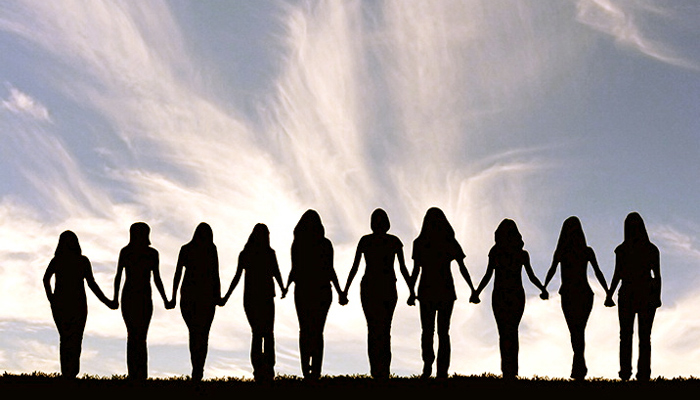
On December 31, 2019, an article in Quartz Magazine claimed that within the LDS Church, women are forbidden from working outside of the home and that they have no choice but to be stay-at-home mothers.
BYU’s marriage rate and culture were used as examples of women within the Church facing oppression from the doctrines and leaders of the Church. The article claims women only attend BYU in order to find husbands.
One of their main sources was Kate Kelly. Her involvement as a leader in the Ordain Women movement led to her excommunication in 2014. She is a human rights lawyer and she married J. Neil Ransom in the Salt Lake Temple in 2006. Following Kelly’s excommunication, the couple divorced in 2016.
Related Link: An Open Letter to Kate Kelly, Ordain Women, & Questioning Onlookers
In a podcast interview with John Dehlin, a fellow excommunicated member of the Church, Kelly stated that “[her] family isn’t involved in the institution anymore,” and claims that she has emotionally moved on from the Church.
Understanding the Facts
Kelly graduated from BYU almost 20 years ago. Since then, the mindset of active LDS women attending BYU has changed. Because Kelly is neither a BYU student or an active LDS woman currently, she is not an expert source for an article addressing the current status of these topics.
To truly understand the context of Kate Kelly and her world at BYU in the early 2000s as compared to the average LDS young woman attending BYU in 2020, we provide a standard Market Basket of goods to illustrate the different world we live in today.
| ITEM | QTY | Price per Unit in 2000 | Price per Unit in 2020 | % difference |
| Private University – Tuition | 1 year | $19,307 | $36,680 | 90% increase |
| Gallon of Gas | 1 gallon | $1.51 | $2.75 | 82% increase |
| Gallon of Milk | 1 gallon | $1.30 | $3.28 | 152% increase |
| Average Rent | 1 month | $602 | $900 | 50% increase |
| Average Cost of a Home | 1 home | $119,600 | $315,00 | 163% increase |
The high cost of living in 2020 versus the cost of living in the early 2000s is significantly different and is a contributing factor to a woman’s decision to work outside the home in order to contribute to the household income.
A single person would need to make at least $67,000 a year in order to afford a median-priced home in Salt Lake City today. Currently, the median annual salary in the US is $56,516. In order for a family to afford a home in addition to food and other necessities, it is almost essential to have a second source of income.
Young women today need to be prepared to be either the primary or secondary source of income in order for their future families to live comfortably.
The Mrs. Degree

Quartz emphasizes that the majority of women attending BYU only attend the university in order to find a husband.
The author quotes Kate Kelly when she says, “The point of Mormon women going to college is to find a spouse, period.” As a current BYU student, I can see why this may have been the case in Kelly’s time, but I don’t believe it is anymore.
It is true that there is a lot of push to get married and start a family while attending BYU. Because of this, many female BYU students recognize the value of marriage while also pursuing a degree.
BYU students are still marrying young, but they are also graduating at a higher rate than they were 20 years ago. In fact, the retention rate of these students is currently higher than the national average.
Attending college to find a spouse may still be a motivator to attend college for some women. But is it the only purpose of college? Retention suggests that increasingly more women are in search of higher education. Whether this is in addition to marriage or on its own. President Howard W. Hunter encourages,
Brothers and Sisters, we need to do everything necessary to adequately prepare ourselves for employment or careers. We owe it to ourselves to do our best, and we owe our best in providing for our families.
With the mindset of preparing to provide for our families, education and marriage are more synonymous than people may think.
Statistically, 84% of BYU students are married by graduation. Similar trends are found at other Christian colleges, for example, Colorado Christian University. 80% of CCU students are married by graduation.
This is due to the religious base on these campuses. It is a common goal among many Christians to refrain from premarital sex. This belief is largely what causes young Christians to marry so quickly when compared to other young adults in America.
A Wage Gap

While the marriage rate on these religious campuses is similar, the annual income of their graduates is staggeringly different. Statistics show that women in LDS homes are paid significantly less than their husbands.
While LDS men are making upwards of $71,000 a year, LDS women are making $800 a year. LDS women are perfectly capable of making more than this, so why aren’t they?
Only 25% of LDS women choose to seek full-time employment. This $800 is an average amount accounting for 100% of LDS women, 75% of whom have chosen not to have any income at all.
The wage gap between men and women is not a new concept, and I do believe that it exists to a certain degree. But Quartz is citing a pay-gap between a man who works and a woman who is unemployed. Of course, there is a huge gap! One of them doesn’t have a steady income because they have chosen to stay home.
Studies also show that women at BYU are most likely to choose a degree in elementary education, human development, psychology, or family systems. Men at BYU are more likely to major in accounting, business, computer science, and finance.
Comparatively, the degrees that women choose to attain generally make less income than those of their male counterparts. Although this income may be less, all of the careers listed pay well over $800 a year.
This “wage gap” exists because of the choices made by individual men and women. It is not a comparison of men and women working in the same field and being significantly under or overpaid.
Higher Education

Another question I have is, if LDS women are only attending universities to find a husband, then why are so many attending graduate school?
For example, according to a friend of Kelly’s, when she attended J. Rueben Clark law school, “maybe two” out of the 50 plus students enrolled were women. Today BYU’s J. Reuben Clark Law School has a graduating class that is 52% women. Nationwide, women make up 52% of law school students.
According to the Utah System of Higher Education, “Nationally, women outpace men in higher education achievement. Utah’s attainment closely mirrors the population — 50 percent women, 50 percent men.”
The Family Proclamation

These numbers do not suggest that LDS women are being oppressed by the leadership of the Church. Quartz suggests that the doctrines of the Church are restrictive stating, “It’s not hard to see how this failure to modernize places undue burden on women.”
To shed some light on this, LDS women make it a personal decision to either stay at home or work outside of the home because they are aware of 2 things. First, as explained in the earlier sections, in today’s economy it is virtually impossible for a family to survive on a single income. And second, the Church’s stance on women’s roles is plainly stated in The Family: A Proclamation to the World.
By divine design, fathers are to preside over their families in love and righteousness and are responsible to provide the necessities of life and protection for their families. Mothers are primarily responsible for the nurture of their children.
Many people like to stop it right here and say, as Quartz does, that, “The Church published its official view on how the family should be composed, noting the ‘divine design’ of a one-income family.” It is important to read the Proclamation in full context. The rest of the text states:
In these sacred responsibilities, fathers and mothers are obligated to help one another as equal partners. Disability, death, or other circumstances may necessitate individual adaptation.
Nowhere does this state that you must have a one-income family. It simply states the primary responsibilities of each partner within marriage.
Saying that fathers are responsible for providing does not disqualify women from working outside the home. Similarly, saying that women are responsible for the nurture of their children does not mean that fathers should be absent.
When spouses treat each other as equal partners, it means that they will assist each other in carrying out their primary responsibilities. In many cases only one parent is present, a child is being raised by grandparents, or there is major familial dysfunction. These primary roles can shift depending on your personal circumstances and the brethren understand and admit that in this very document.
All Things in Context

Context and factoring context into the information that is presented to us is of paramount importance in our lives. Articles like the one published by Quartz are an example of tunnel vision—ignoring the surrounding context. To understand what I mean, answer this question:
What is happening in the picture above?
a. He is walking his son to school.
b. They are tourists in a new city.
c. They are taking family pictures.
d. None of the above.
It’s easy to look at a statistic and think that women making $800 is because of an unfair wage gap. What is harder is to understand the context behind why that number may be so small.
It’s simple to say that the Church’s stance on working women is rigid if you leave out part of a quote or statement.

And it’s easy to assume that someone is simply walking their son to school when they are really protesting in the street. It is so important to have the full picture.
Women In and Out of the Home

Quartz states that “It’s explicit. [The prophets say] point-blank that women are not to work outside the home. This is not optional. What Mormons say is, ‘The thinking has been done.’”
The author also states that being a stay-at-home mom is fed to LDS girls starting at a young age. She quotes Kate Kelly saying,
“Throughout Sunday school and other forms of Mormon education, Mormon girls are explicitly told that their college education is predominantly a back-up if ever accidentally your husband were to die or you found yourself in a position where you had to earn a living. But otherwise, you are not to use it.”
The statements made in the Family Proclamation allow room for individual adaptation. This means that the women who abide by these standards are diverse in their ways of life and motherhood.
LDS Women may choose to stay home because they feel that it is the best way to follow the prophet’s counsel. If a woman isn’t pursuing something that she earned her degree in, that doesn’t mean that she’s being oppressed by the Church. Many women who choose to stay home are doing what they have always wanted to do, which is to be a mother.
Many other women choose to work outside of the home. There are various reasons for this. Providing a steady income for their families, or to be fulfilled intellectually are just two of many. There are also women who would love to stay home with their children but circumstances will not allow it.
Related Link: 12 Awesome Quotes About Women NOT About Motherhood
Whatever your circumstance may be, President Hinkley stated, “Do the very best you can. You know your circumstances, and I know that you are deeply concerned for the welfare of your children.”
We can support stay-at-home mothers and mothers who work outside of the home. These lifestyle choices can and do coexist within the Church.
Empowered or Overpowered?

A final excerpt from the Quartz article states, “As the pressures on the LDS community have shifted, the Church’s official stance on women’s rights and obligations has grown more rigid and conservative.”
From a secular view, this may seem to be the case. In reality, the Church’s view of women has stayed constant and unchanging as the views of the world have rapidly changed.
In the most recent General Conference, our prophet, President Russel M. Nelson spoke about the power that women hold within the Church. He stated,
If you are endowed but not currently married to a man who bears the priesthood and someone says to you, “I’m sorry you don’t have the priesthood in your home,” please understand that that statement is incorrect. You may not have a priesthood bearer in your home, but you have received and made sacred covenants with God in His temple. From those covenants flows an endowment of His priesthood power upon you.
He continues, “The heavens are just as open to women who are endowed with God’s power flowing from their priesthood covenants as they are to men who bear the priesthood. I pray that truth will register upon each of your hearts because I believe it will change your life.”
These views stated by our prophet do not indicate a rigid patriarchal system. In fact, they do the complete opposite by informing women of the power they have always had available to them.
LDS women are strong, faithful, and powerful. We are agents unto ourselves and we are equals with our husbands.
So thanks for your opinion Quartz, but I’m not oppressed.
Have you read the Quartz article? What did you think? Share in the comments.



